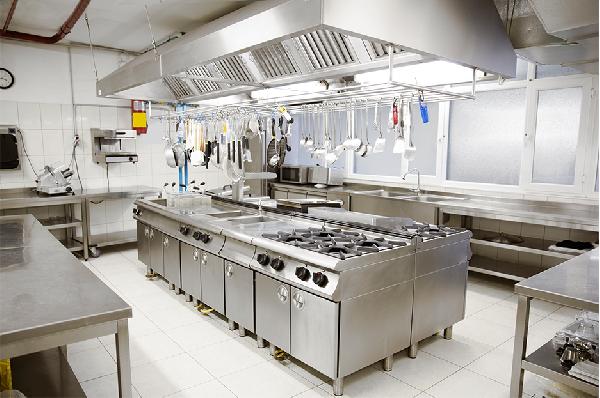Features of an Effective Commercial Kitchen Ventilation System Existing systems should be assessed and new systems planned to meet these ventilation objectives. The guidance given below indicates the design features and criteria which have been found suitable and effective in catering kitchens.
Canopies: Design Air needs to be removed at a constant rate from cooking and subsidiary areas, to take away combustion fumes and cooking odours as close to source as possible. It is advisable that the bulk of extraction from the kitchen is via hoods above gas-fired and all other appliances capable of generating heat, water vapour, fumes and odours. The plan dimension of the Kitchen Chimney Manufacturer in Pune is recommended to exceed the plan area of cooking appliances. An overhang of 250-300 mm all round for island canopies is normally adequate. Wall-mounted canopies normally have a front overhang of 250 mm at the front and 150 mm at the ends. Greater overhangs may be required at some appliances. Canopies should not be so low as to form an obstruction. Canopies and ductwork need to be constructed from non-combustible material and fabricated so as not to encourage accumulations of dirt or grease, nor allow condensation to drip from the canopy. The ductwork needs suitable access for cleaning and grease filters need to be readily removable for cleaning/replacement. Experience will indicate how frequently cleaning is needed. The design and performance of canopies need to be effective in removing cooking fumes from source and, as far as possible, preventing them from passing through the breathing zone of the cook. Canopies: performance The amount of air to extract via the Kitchen Chimney is best calculated from the information supplied with the appliances within the kitchen, and not by simply using general advice on air changes alone. For example, the air velocities over the hood face specified for individual items can be added up to give the total air movement. Where the ventilation requirements of cooking equipment are not available, an approximate air flow rate in litres per second (L/S) can be calculated from the total hood size and the following minimum hood face velocities: 0.25 m/s, for light; 0.4 m/s for medium and 0.5 m/s for heavy duty cooking. Ventilation rates are best specified as air velocities into the canopy rather than standard air changes per hour. As a guide, a ventilation rate of not less than 17.5 L/S per square metre of floor area and not less than 30 air changes per hour (ACH) is advisable. A lower ACH figure (eg 10) may be needed to avoid discomfort from draughts where the kitchen is subdivided into separate rooms (eg wash-ups, vegetable preparations). Looking for Kitchen Shutters Supplier in Pune? Replacement Air: Air to replace that extracted and used by combustion needs to be replaced. Typically, 85% of the total air needed is supplied by a mechanical ventilation system together with 15% make up air drawn from adjoining areas. This arrangement keeps the kitchen under negative pressure to prevent escape of cooking odours. In smaller kitchens sufficient replacement air may be drawn in naturally via ventilation grilles in walls, doors or windows. Where such incoming air is drawn in naturally some means of control over pest entry is usually required. If a fine mesh grille is used this will restrict the ventilation, but a larger overall grille size can compensate. However, for larger installations this would require a grille so large that a mechanical system using a fan and filter would be more suitable. The air needs to be drawn from an adjacent area where it is clean. Where smoking is allowed such as in an adjoining Dining Table Dealer in Pune it is advisable not to draw this air into the kitchen as make up air. Where make up air is drawn via serving hatches or counters it is recommended the air velocities do not exceed 0.25 m/s to avoid complaints of draughts. However, higher velocities may be tolerated or desirable at hot serving counters. The incoming air from the ventilation system needs to be arranged so as not to adversely affect the performance of the flue at any open flued gas appliances. The make up air can be drawn in through permanent grilles, but they need to allow for between 1.0 and 1.5 m/s air flow velocity. Cooling air The effective balancing of incoming and extracted air, together with removal at source of hot vapours as above should help prevent the kitchen becoming too hot. The replacement air inlets from any mechanical ventilation systems can be positioned to provide cooling air over hot work positions. If this is still not enough, some form of overhead air outlet discharging cool air or air conditioning may be required. Local freestanding fans are not recommended. They may spread micro-organisms or set up air currents or turbulence affecting the efficiency of the designed ventilation systems. They also introduce other hazards such as tripping and electric shock hazards from the trailing cable. As part of a balanced ventilation system fans fixed to the structure could be considered. Discharge High level discharge of extracted air with discharge velocities of about 15 m/s are often needed to prevent nuisance to neighbouring properties. ‘Chinaman’s hats’ on discharge stacks are not recommended as they encourage down draught and re entry of fumes into the building. |
